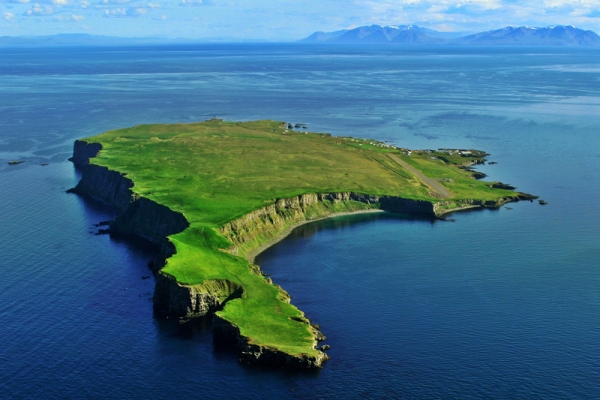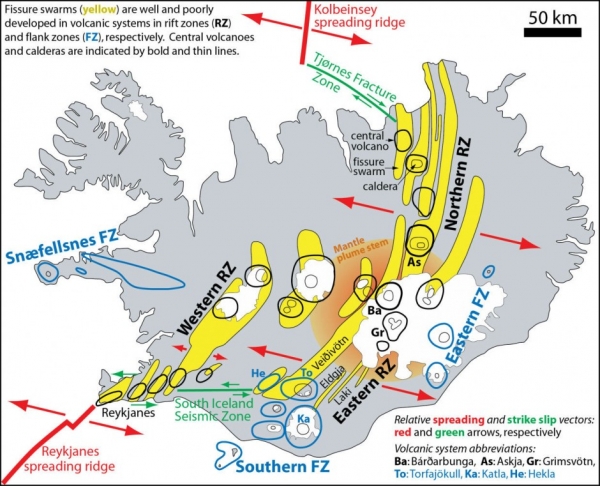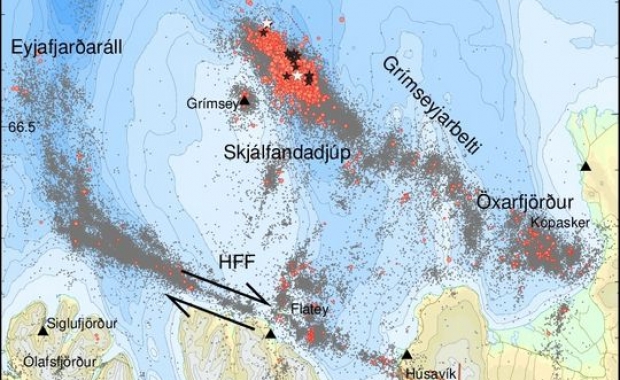The swarm shaking the tiny Grímsey island, the most remote and northernmost settlement in Iceland has continued unabated over the weekend. The intense seismic episode appears to have changed character, becoming more intense with a higher frequency of powerful quakes.
The swarm originated in the submarine Tjörnes fracture zone which is created by the movement of the continental plates in opposite directions. It is still too early to say whether the quakes are a harbinger of anything bigger, an volcanic eruption or a massive earthquake. Geophysicists and seismologists have not detected any immediate signs of volcanic activity in connection to the quakes.
Read more: Grímsey earthquake swarm still gathering strength: 64 powerful 3+ quakes in past 48h

Eruptions are not common in the system, which is known for high levels of seismic and geothermal activity. The last known volcanic eruption in the Tjörnes fracture zone took place in 1867, south of Grímsey. Two eruptions near Grímsey were recorded in 1372 and 1785 in old annals. However, it should be kept in mind that submarine eruptions are difficult to detect without modern scientific equipment, and the frequency of eruptions in the system in previous centuries could have been far higher than written records suggest.
Geophysicists believe that it is more likely that the intense seismic activity is a predecessor for a massive earthquake. Powerful earthquakes in the Tjörnes fracture zone are frequently preceded by intense earthquake swarms. A 7+ quake was recorded in 1910.
The epicenter of the quakes has been at significant depths of several kilometers.
Read more: What's going on in Grímsey? Intense earthquake swarm likely a harbinger of something bigger
The quakes began late afternoon on Wednesday and has continued unintirrupted. Since the swarm began nearly 3,0000 quakes and tremors have been detected. Most of the quakes have been relatively small, 1-2 on the Richter scale, but the swarm has included nearly 100 relatively powerful 3+ quakes. Any quake larger than 2.5 on the Richter scale can be felt clearly in the small village on Grímsey island.
A Grímsey resident told the National Broadcasting Service that the quakes are becoming very annoying and disturbing.

The swarm shaking the tiny Grímsey island, the most remote and northernmost settlement in Iceland has continued unabated over the weekend. The intense seismic episode appears to have changed character, becoming more intense with a higher frequency of powerful quakes.
The swarm originated in the submarine Tjörnes fracture zone which is created by the movement of the continental plates in opposite directions. It is still too early to say whether the quakes are a harbinger of anything bigger, an volcanic eruption or a massive earthquake. Geophysicists and seismologists have not detected any immediate signs of volcanic activity in connection to the quakes.
Read more: Grímsey earthquake swarm still gathering strength: 64 powerful 3+ quakes in past 48h

Eruptions are not common in the system, which is known for high levels of seismic and geothermal activity. The last known volcanic eruption in the Tjörnes fracture zone took place in 1867, south of Grímsey. Two eruptions near Grímsey were recorded in 1372 and 1785 in old annals. However, it should be kept in mind that submarine eruptions are difficult to detect without modern scientific equipment, and the frequency of eruptions in the system in previous centuries could have been far higher than written records suggest.
Geophysicists believe that it is more likely that the intense seismic activity is a predecessor for a massive earthquake. Powerful earthquakes in the Tjörnes fracture zone are frequently preceded by intense earthquake swarms. A 7+ quake was recorded in 1910.
The epicenter of the quakes has been at significant depths of several kilometers.
Read more: What's going on in Grímsey? Intense earthquake swarm likely a harbinger of something bigger
The quakes began late afternoon on Wednesday and has continued unintirrupted. Since the swarm began nearly 3,0000 quakes and tremors have been detected. Most of the quakes have been relatively small, 1-2 on the Richter scale, but the swarm has included nearly 100 relatively powerful 3+ quakes. Any quake larger than 2.5 on the Richter scale can be felt clearly in the small village on Grímsey island.
A Grímsey resident told the National Broadcasting Service that the quakes are becoming very annoying and disturbing.








